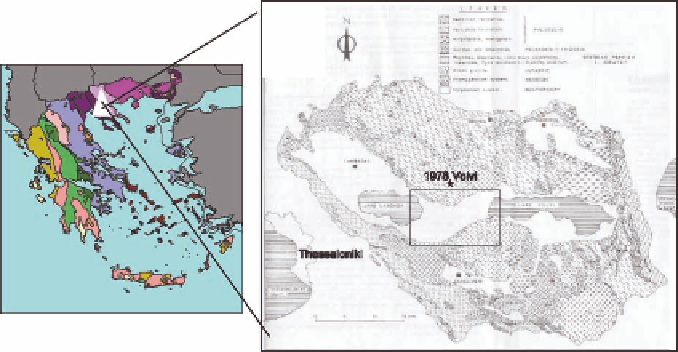Geoscience Reference
In-Depth Information
Anumberofrelatedcollaborativeresearcheffortswillbealsohighlightedtodemonstrate
the strong potential of such large-scale research facilities. In this regard, international
worldwide collaboration appears to be a critical element in harnessing the power of this
newexperimentationapproach,andtherelatedvalidation/verificationefforts,andassoci-
ated positive implications for the state of practice.
2. Instrumented test sites
2.1. EUROSEIS PROJECT
EUROSEISisalargephysicallaboratory(TestSite),locatedatadistanceof30kmfrom
Thessaloniki (at the epicentral area of the M6.5 1978 earthquake), in northern Greece
(Figure 5.1). About 150 seismic events have been recorded. Of those, about fiveevents
are considered of moderate strength with peak acceleration of as much as 130gals. The
remainder are weak tremors with peak accelerations of about 50gals. The EUROSEIS-
RISK project encompasses integrated experimental and theoretical research studies in
seismology, applied geophysics, engineering seismology, earthquake engineering, soil
dynamics,andstructuralengineering.Specifictopicsincludeseismichazardassessment,
monitoringofseismicity(Table5.1),designoftwo-dimensional(2D)and3Dsoilmodels
for site response evaluation, 2D/3D theoretical computations, site effects, soil-structure
interaction (SSI) effects in the presence of yielding buildings or bridges, and validation
ofretrofittingtechniques(http://euroseis.civil.auth.gr,Euroseistest1993-1995,Euroseis-
mod 1996-1998, and EUROSEISRISK Seismic 2002-2005).
Fig. 5.1. Location of the testsiteinGreece, and Tectonic sketch of the Mygdonian
basintogether withtheinvestigated area (box) and theepicentre of the 1978
Ms
=
6
.
5 Volvi earthquake (shown bythe star)

